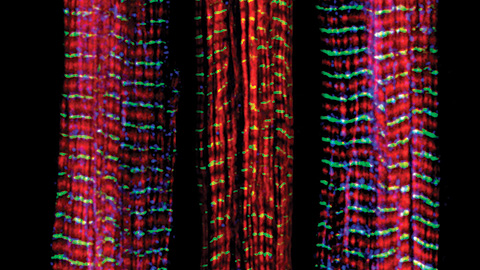From the journals: JLR
How lipid rafts are formed, how good cholesterol goes bad and the role of a new drug in cholesterol trafficking. We offer a selection of papers on these topics recently published in the Journal of Lipid Research.
Shedding light on lipid raft formation
A major recent advance in our understanding of cellular membranes is the discovery of so-called lipid rafts or nanodomains. These domains are membrane regions enriched for certain lipids and proteins and are predicted to be important for a range of biological processes. With many questions outstanding on their function, structure and formation, nanodomains are the subject of significant research in the field of lipid membranes.
Attempts to study these nanodomains, however, have been hampered by difficulties in detection, leading many studies to use model membranes called giant plasma membrane vesicles, or GPMVs, at low temperatures (0°C to 20°C). These conditions induce larger-scale membrane ordering that can be detected by basic light microscopy techniques. While such studies have been valuable, researchers remain concerned that low temperature studies on these large-scale phase separations do not represent accurately the behavior of smaller nanodomains in human cells under physiological conditions.
In a recent paper published in the Journal of Lipid Research, a team from Stony Brook University led by Guangtao Li write that they were able to circumvent this common shortcoming. The researchers used a technique called Förster resonance energy transfer, which sensitively can detect low nanometer distances between labeled lipids otherwise undetectable by normal microscopy. With this technique, the researchers detected nanodomain formation in GPMVs at temperatures at least as high as 38 degrees, where larger-scale separations disappear, confirming that nanodomains occur at physiological temperatures. Li and colleagues also were able to modulate the lipid and cholesterol compositions of their GPMVs, confirming that differing membrane compositions could influence domain formation.
With the importance of nanodomains in normal cellular function, the ability to study these domains under more biologically relevant conditions is invaluable. Future research not only could expand our scientific knowledge of nanodomain behavior but potentially allow scientists to target and manipulate these domains for new drugs and treatments.

Good cholesterol gone bad in coronary heart disease
High-density lipoprotein, commonly called HDL, often is referred to as “good cholesterol” for the beneficial role it plays in maintaining cholesterol balance in the body. HDL also has been shown to mediate coronary heart disease, or CHD, but so far clinical trials of drugs that target HDL have failed. According to Katrin Niisuke and a joint team from Tufts University and the Centers for Disease Control and Prevention, our limited knowledge of the composition–function relationship in HDL particles could be a reason for those failures. In new research published in the Journal of Lipid Research, the researchers sought to elucidate better the role of lipid composition in HDL function.
Using samples from CHD patients and healthy controls, Niisuke and colleagues were able to separate out large and small HDL particles and characterize their lipid compositions. Compositional differences were found between the large and small particles in all patient groups, but differences in both lipid composition and the function of apoA-1 between healthy subjects and CHD patients were primarily in the large particles. These large particles influence cholesterol control through the scavenger receptor class B type 1 pathway; thus, this research not only provides a deeper understanding of the composition–function relationship of HDL but also could inform development of treatments for CHD.
A new drug’s role in cholesterol trafficking
Niemann–Pick type C disease, or NPC, is a fatal genetic disorder that results in the accumulation of excess cholesterol in lysosomes, a key waste disposer in cells. While there are no approved drugs to treat NPC, 2-hydroxypropyl-beta-cyclodextrin, or CD, is a promising molecule currently in human trials. However, researchers know little about the details of CD’s mechanism of action. Previous studies have shown CD to decrease lysosomal cholesterol accumulation but also have shown no effect on total cellular cholesterol. To reconcile these seemingly disparate findings, McKenna Feltes and a team from Washington University labeled cholesterol and tracked its movement through model NPC cells treated with CD.
In a paper published in the Journal of Lipid Research, Feltes and her colleagues were able to confirm CD-dependent decrease in lysosomal cholesterol levels. Rather than removing this cholesterol from the cell, however, CD promoted transfer of lysosomal cholesterol to the plasma membrane. From there, cholesterol either would exchange with lipoprotein-bound cholesterol or be routed to the endoplasmic reticulum for processing if excess accumulation occurred. These findings provide a more complete picture of CD’s role in mediating cholesterol homeostasis in NPC and could prove useful in CD’s continued development as a drug for this disease.
Enjoy reading ASBMB Today?
Become a member to receive the print edition four times a year and the digital edition monthly.
Learn moreGet the latest from ASBMB Today
Enter your email address, and we’ll send you a weekly email with recent articles, interviews and more.
Latest in Science
Science highlights or most popular articles

The science of staying strong
Muscles power every movement, but they also tell the story of aging itself. Scientists are uncovering how strength fades, why some species resist it and what lifestyle and molecular clues could help preserve muscle health for life.

Bacteriophage protein could make queso fresco safer
Researchers characterized the structure and function of PlyP100, a bacteriophage protein that shows promise as a food-safe antimicrobial for preventing Listeria monocytogenes growth in fresh cheeses.

Building the blueprint to block HIV
Wesley Sundquist will present his work on the HIV capsid and revolutionary drug, Lenacapavir, at the ASBMB Annual Meeting, March 7–10, in Maryland.

Gut microbes hijack cancer pathway in high-fat diets
Researchers at the Feinstein Institutes for Medical Research found that a high-fat diet increases ammonia-producing bacteria in the gut microbiome of mice, which in turn disrupts TGF-β signaling and promotes colorectal cancer.

Mapping fentanyl’s cellular footprint
Using a new imaging method, researchers at State University of New York at Buffalo traced fentanyl’s effects inside brain immune cells, revealing how the drug alters lipid droplets, pointing to new paths for addiction diagnostics.

Designing life’s building blocks with AI
Tanja Kortemme, a professor at the University of California, San Francisco, will discuss her research using computational biology to engineer proteins at the 2026 ASBMB Annual Meeting.

